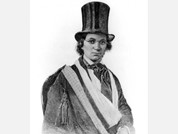Ellen and William Craft: Performing Freedom
Everywhere slavery was practiced, enslaved people resisted. Ellen Craft and her husband, William, escaped from bondage in Georgia in 1848. Defying class, gender, and race boundaries, their performance of freedom centred on identity transformation and racial passing.
Their plan to escape American slavery was simple yet remarkable. The elaborate performance of freedom relied on Ellen’s acute understanding of how the white people she encountered would expect elite whiteness to look and behave. Despite being legally defined as Black, Ellen’s white skin tone supported her passing as a sick, elderly white man. Dressed in the fashion of a wealthy white man, Ellen wore a top hat and suit, and disguised her inability to sign documents, including hotel guestbooks, by wearing her arm in a sling. William posed as her enslaved servant.
After their successful escape, the Craft’s became leading voices in the abolitionist movement, speaking to audiences in the United States and Britain. They spoke in several locations in and around Bristol in the 1850s and 1860s.
The story of the Crafts is a remarkable one for the brilliance of their performance. Yet their story represents just one of the thousands of men and women who fled for freedom, and the many who engaged in dangerous defiance of the boundaries of race and privilege to claim the freedom they were denied.
by Ella Wright
